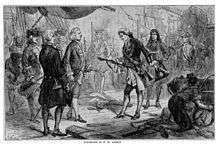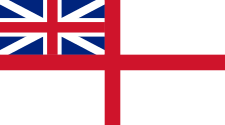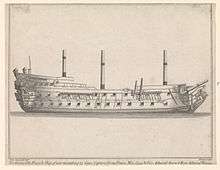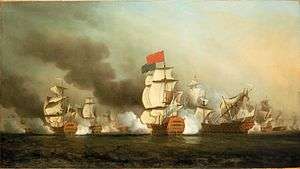First Battle of Cape Finisterre (1747)
| ||||||||||||||||||||||||||||||
The First Battle of Cape Finisterre (14 May 1747[3]) saw 14 British ships of the line under Admiral George Anson attack a French 30-ship convoy commanded by Admiral de la Jonquière during the War of the Austrian Succession. The British captured 4 ships of the line, 2 frigates and 7 merchantmen, in a five-hour battle in the Atlantic Ocean off Cape Finisterre in northwest Spain. One French frigate, one French East India Company warship and the other merchantmen escaped.
Events
Prelude
France needed to keep shipping lanes open in order to maintain her overseas empire. To this end she assembled merchantmen into convoys protected by warships. Anson on Prince George and Rear-Admiral Sir Peter Warren on Devonshire had sailed from Plymouth on 9 April to intercept French shipping. When a large convoy was sighted Anson had made the signal to form line of battle. When Rear-Admiral Warren, suspecting the enemy to be merely manoeuvring to promote the escape of the convoy, bore down and communicated his opinion to the admiral, the latter threw out a signal for a general chase.
Battle
Centurion under a press of sail, was the first to come up with the rearmost French ship, which she attacked heavily and two other ships dropped astern to her support. The action became general when three more British ships, including Devonshire, came up. The French, though much inferior in numbers, fought till seven in the evening, when all but two of their ships were taken, as well as nine East India merchantmen. The French lost 700 men killed and wounded, and the British 520. Over £300,000 was found on board the ships of war, which were turned into British ships.
Aftermath

Following his victory, Anson was raised to the peerage. The French assembled another, much bigger, convoy which set sail in October; Hawke's defeat of this fleet in the Second Battle of Cape Finisterre put an end to French naval operations for the rest of the war. François de Grasse later the famous Comte was wounded and taken prisoner as he served on Le Gloire which was captured.
According to historian William Williamson, the battle was a "most severe blow to the French interests in America. Besides immense property taken, there were found on board … numerous articles designed for the Acadians and Indians" who continued to resist the British in Acadia/ Nova Scotia.[4]
Order of battle
 Britain (George Anson)
Britain (George Anson)
- Prince George 90 (flag) - Vice-Admiral George Anson, Captain John Bentley
- Devonshire 66 - Rear-Admiral Peter Warren, Captain Temple West
- Namur 74 - Captain Edward Boscawen
- Monmouth 64 - Captain Henry Harrison
- Prince Frederick 64 - Captain Harry Norris
- Yarmouth 64 - Captain Piercy Brett
- Princess Louisa 60 - Captain Charles Watson
- Nottingham 60 - Captain Philip Saumarez
- Defiance 60 - Captain Thomas Grenville
- Pembroke 60 - Captain Thomas Fincher
- Windsor 60 - Captain Thomas Hanway
- Centurion 50 - Captain Peter Denis
- Falkland 50 - Captain Blomfield Barradell
- Bristol 50 - Captain William Montagu
- Ambuscade 40 - Captain John Montagu
- Falcon 10 (sloop)
- Vulcan 8 (fireship)

 France (de la Jonquière)
France (de la Jonquière)
- Sérieux 64 (flag) — captured
- Invincible 74 — captured
- Rubis 52 — captured
- Jason 50 — captured
- Gloire 40 — captured
- Emeraude 40 — escaped
- Chimère 36 — escaped
- Diamant 30/56 — captured, sunk later
- Apollon 30 — captured
- Philibert 30 — captured
- Thétis 22 — captured
- Vigilant 20 — captured
- Modeste 18 — captured
- Dartmouth 18 (ex-British privateer) — captured
- Convoy of 24 ships or fewer — 6 captured
See also
Notes
- ↑
- "...the standard of France was white, sprinkled with golden fleur de lis..." (Ripley & Dana 1879, p. 250).
- On the reverse of this plate it says: "Le pavillon royal était véritablement le drapeau national au dix-huitième siecle...Vue du chateau d'arrière d'un vaisseau de guerre de haut rang portant le pavillon royal (blanc, avec les armes de France)" (Vinkhuijzen collection 2011).
- "The oriflamme and the Chape de St Martin were succeeded at the end of the 16th century, when Henry III., the last of the house of Valois, came to the throne, by the white standard powdered with fleurs-de-lis. This in turn gave place to the famous tricolour"(Chisholm 1911, p. 460).
- 1 2 Allen, Joseph (1852). Battles of the British navy, Volume 1. London: Henry G. Bohn. p. 160.
- ↑ in the Julian calendar then in use in Britain this was 3 May 1747
- ↑ William Williamson, p. 253
References
 Chisholm, Hugh, ed. (1911). "Flag". Encyclopædia Britannica. 10 (11th ed.). Cambridge University Press. pp. 454–463.
Chisholm, Hugh, ed. (1911). "Flag". Encyclopædia Britannica. 10 (11th ed.). Cambridge University Press. pp. 454–463. Ripley, George; Dana, Charles A., eds. (1879). "Flag". The American Cyclopædia. 8. p. 250.
Ripley, George; Dana, Charles A., eds. (1879). "Flag". The American Cyclopædia. 8. p. 250.
- "The Vinkhuijzen collection of military uniforms: France, 1750-1757". New York Public Library. 25 March 2011 [2004]. Archived from the original on 8 March 2013.
